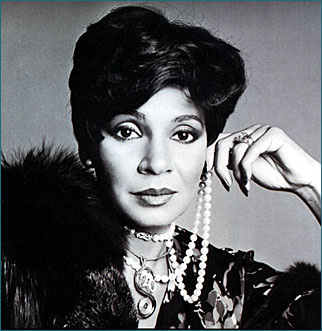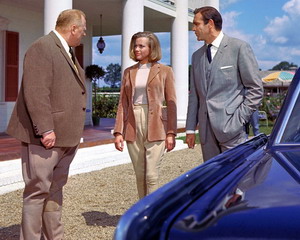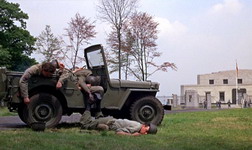Goldfinger (1964) is, without the trace of a doubt, one of the most mythical titles of the Bond saga, and due to loads of reasons: the Fort Knox assault, its famous main song, the first appearance of the Aston Martin DB5, its villain, Guy Hamilton’s flawless direction, its masterful introduction…
This installment in the saga is part of Bond’s golden history, including all the elements that made the franchise well-known and recognizable (in spite of the Brosnan period, which gave us a modern Bond, distorted and far away from the canon).
If the path for the saga was established with From Russia with Love (1963), Goldfinger clearly consolidated it, starting with the main credits song and ending with the superb climax.
You can also read Goldfinger in Spanish
Goldfinger – The Man with the Midas Touch
Auric Goldfinger is a great villain, really obnoxious, rich and vile on all sides, not without a certain sarcastic black humor, fairly straightforward on the other hand, as heard in the brilliant dialogue of the laser torture (007: “Do you expect me to talk?” – Goldfinger: “No, Mister Bond…I expect you to DIE!”).
His plan, as ingenious as twisted, is to contaminate the gold in Fort Knox with a radioactive bomb, so gold market price rises. This will allow that “his” illegal gold, under transaction for quite long (especially with his Chinese communist partners) increases its value.
After one of the best prologues in the series, James Bond is sent to Miami, where he must monitor Goldfinger. Bond will suffer from overconfidence, after seducing one of Auric’s assistants and showing up the man himself while cheating playing cards. Beaten and knocked down in his apartment, Bond will discover the girl he had seduced (which ultimately betrayed Goldfinger) dead in his bed, completely covered in gold.
 007 is told off by M, his boss, who reminds him to forget about personal revenge. Then, Bond is assigned to tail Goldfinger and his henchman, Oddjob (a huge, burly Korean with a deadly hat launch). His mission: finding out about their operations.
007 is told off by M, his boss, who reminds him to forget about personal revenge. Then, Bond is assigned to tail Goldfinger and his henchman, Oddjob (a huge, burly Korean with a deadly hat launch). His mission: finding out about their operations.
He will soon discover how the gold moves, after following it through the Alps and reaching Auric’s company. Bond will be captured there and will end up learning about Operation GrandSlam. Then he will meet Pussy Galore, played by the gorgeous Honor Blackman (of The Avengers fame). Her beautiful she-pilots posse will be essential to carry out Goldfinger’s diabolical plan.
But Bond will triumph, starting with Pussy Galore’s seduction and ending with a fantastic raid in Fort Knox. The final fight will be first against Oddjob and, then, on a jet, against Goldfinger.
One of the Best Bonds, by Guy Hamilton
And it was not surprising that this film was a box office hit. Its masterful direction, with a pulse, craft and rhythm, unveiled Guy Hamilton’s talent as one of the best directors in the franchise, along Terence Young.
 Both of them were, as a matter of fact, responsible of molding the set pieces in the saga: spectacular action scenes, carefully looked after staging, masterful cinematography and special effects, a wonderful art direction, playful scripts…
Both of them were, as a matter of fact, responsible of molding the set pieces in the saga: spectacular action scenes, carefully looked after staging, masterful cinematography and special effects, a wonderful art direction, playful scripts…
James Bond is more than Pierce Brosnan‘s exaggerated movies (an actor I really like and that fitted perfectly in the role). Bond is not just chases and exaggeration, he is more than the action hero we saw in the 90s. And that is something that the franchise lost after Roger Moore’s departure and, especially, Brosnan’s entrance. And that is something that Terence Young and Guy Hamilton managed to deploy, becoming the visual footprint of the best Bonds.
Stories and Trivia
As usual, there are many anecdotes, as in most of the Bond Universe, but some of them could be mentioned.
To begin with, the franchise premieres a new car, which becomes a classic and reappears in many subsequent Bond films: Aston Martin DB5, a vehicle that incorporated all type of gadgets.
 Ian Fleming,who died in 1964, before the film was finished, took the villain name from his neighbor, Erno Goldfinger. Curiously, there were several changes from the novel, but the most important one was that the film disregarded Goldfinger’s ties with Spectre, making him cooperate with communist China (in fact, this is the first and only Connery movie without the presence of Spectre).
Ian Fleming,who died in 1964, before the film was finished, took the villain name from his neighbor, Erno Goldfinger. Curiously, there were several changes from the novel, but the most important one was that the film disregarded Goldfinger’s ties with Spectre, making him cooperate with communist China (in fact, this is the first and only Connery movie without the presence of Spectre).
Director Terence Young was not available for the third entry in the series, as he was immersed in the filming of The Amorous Adventures of Moll Flanders (1965), in addition to veiled differences with the producers of the films about the profit percentages to be received. Guy Hamilton took over, compensating for having declined Dr. No. Besides, Guy and Ian met during World War II in naval intelligence.
For security reasons, the team was not allowed to film inside Fort Knox, although exterior and aerial shots were granted, with interiors being reproduced in the legendary Pinewood Studios, using the imagination, courtesy by Ken Adams.
The awesome opening credits include scenes from Dr. No and From Russia with Love, something that will happen again in On Her Majesty’s Secret Service (1968). It won’t be till The Spy Who Loved Me (1977) that James Bond appears again in the opening credits.
Sean Connery got a back injury during the final fight with Oddjob in Fort Knox, resulting in a shooting delay of several days.

Goldfinger includes the presence of CIA agent Felix Leiter, a character who appears in eleven Bond films(counting the unofficial Never Say Never Again and an episode of the TV series Climax!, Casino Royale, based in the novel by Ian Fleming). In the list of official films, the actors who played the role are: Jack Lord in Dr. No (1962), Cec Linder in Goldfinger (1964), Rik Van Nutter in Thunderball (1965), Norman Burton in Diamonds Are Forever (1971), David Hedison in Live and Let Die (1973) and License to Kill (1989), John Terry in The Living Daylights (1987), and Jeffrey Wright in Casino Royale (2006) and Quantum of Solace (2008).
And last but not least, the voice of the German actor Gert Fröbe, who plays Auric Goldfinger, had to be dubbed due to his strong accent. This was done by British actor Michael Collins.
John Barry is The Man, The Man with the Midas Touch
 Following his short but intense introduction into film music (highlighting his arrangement for the James Bond Theme and his masterful score for From Russia with Love, not to mention the great Beat Girl), John Barry started to consolidate his career in 1964, the year of Goldfinger, the film that got his name in golden letters. Barry, John Barry.
Following his short but intense introduction into film music (highlighting his arrangement for the James Bond Theme and his masterful score for From Russia with Love, not to mention the great Beat Girl), John Barry started to consolidate his career in 1964, the year of Goldfinger, the film that got his name in golden letters. Barry, John Barry.
Perhaps Goldfinger, compared to From Russia with Love, does not have the same thematic richness (not all compositions need it), but it is an absolutely iconic title. Its main song (his awesome leitmotiv) became a real hit, reaching number one in the US, ousting A Hard Day’s Night, by The Beatles (in fact, John Barry received a Golden Record for selling over a million dollars).
It is one of the best songs in the franchise (if not the best, in my opinion), indelibly molding what a Bond song should be. And part of it is due to Shirley Bassey’s incredible voice. She did not hesitate to sing when she discovered the sheer quality of the theme (in fact, Barry and Bassey would work together again on two other Bond entries, Diamonds are Forever and Moonraker), without leaving aside the wonderful lyrics, written by Anthony Newly and Leslie Bricuse.
 And how to forget the nuisance it was for Michael Caine, when he shared his flat with his friend Barry for a short period of time? As Caine puts it, he found Barry one day sleeping on the piano and prepared breakfast, finding out just then the film title and that Barry had, at last, finished the song.
And how to forget the nuisance it was for Michael Caine, when he shared his flat with his friend Barry for a short period of time? As Caine puts it, he found Barry one day sleeping on the piano and prepared breakfast, finding out just then the film title and that Barry had, at last, finished the song.
And so began one of the most iconic musical installments in the saga, which would set the path for the rest of the franchise, and one of Barry’s best works, one of those you NEVER get tired of listening to again and again, from its great prologue to the end.
A five star album, a real ten out of ten.
The Score – Main Themes
 As previously mentioned, From Russia with Love is thematically richer. But Goldfinger’s fewer themes, especially the main one, get it half step above (and that comes from one that deeply loves the score of From Russia with Love).
As previously mentioned, From Russia with Love is thematically richer. But Goldfinger’s fewer themes, especially the main one, get it half step above (and that comes from one that deeply loves the score of From Russia with Love).
The score is based on a main theme that sustains the full film, undergoing multiple, masterful variations, as we will see later, including the legendary James Bond Theme (Monty Norman’s one, as arranged by Barry) and a secondary, though interesting, one for Oddjob, Goldfinger’s right hand.
–James Bond Theme: Obviously, the Crown jewel, 007’s essence, which especially brightens the vibrant prologue (Bond Back in Action Again).
–Goldfinger Theme: The meaning of the Crown jewel. An awesome theme: strong, with personality, where the brass section (trumpets and horns) state the theme masterfully, accompanying the string section as reinforcement or as a melodic element (Barry’s trade mark). From the song to its instrumental rendition, without forgetting the assault on Fort Knox or the scenes in the Alps, the theme supports the movie each time we hear it.
–Oddjob Theme: Not a memorable motif in essence, but effective. Barry uses a set of oriental percussion (a kind of metallic chimes) which sounds threatening and illustrates both menace and the murderer’s origin, as heard in Golden Girl.
Besides all that, there are other “thrilling” musical trends, already used in From Russia with Love and which will keep on appearing in later films (apart from a great theme for the initial scenes in Miami).
Score Analysis – Goldfinger, the Song
The album released by EMI, in its latest edition, includes the score plus a series of bonus tracks (though, still, there are some minor elements missing, as the theme that is heard when Bond arrives in Kentucky, with a Texan flavor).
 As it happens in many other James Bond albums, the tracks are not in chronological order. The first track opens with Shirley Bassey’s song and not with the Gun Barrel (which appears in track 5, Bond Back in Action Again).
As it happens in many other James Bond albums, the tracks are not in chronological order. The first track opens with Shirley Bassey’s song and not with the Gun Barrel (which appears in track 5, Bond Back in Action Again).
This song, perhaps the best ever written for the Bond Universe, conveys everything a 007 song should convey: rhythm and elegance, glamour, courtesy of a John Barry in grace.
The brass section is thunderous, emerging powerfully to state Goldfinger’s theme, accompanied by a wonderful percussion (drums and tambourine), only minimized by Shirley Bassey’s great voice, announcing Goldfinger’s name in one of those wonderful, iconic stanzas: “Goldfinger, He’s the Man, the Man with the Midas Touch”.
And, of course, on top of the elegance, the string section, the violins, enveloping everything with a subtle, wonderful accompaniment, enhancing the stanzas sung by Bassey.
Goldfinger was, is and will be, for ever and ever, one of the best songs ever written for a film, legendary and unfairly set aside by that glamour which supposedly ruled and prevailed in Hollywood (glamour that today exists no longer, becoming a dollar producing machine serving the studios). But to be honest… who cares? Many Oscar winners would like to make history as Barry did in 1964.
The song’s melody will be the main focus of the score, becoming the cornerstone of the composition alongside the recognizable Bond sound of the theme composed by Monty Norman (controversy aside).
Score Analysis – Part I: Gun barrel, Miami & Golden Girl
The first cue in the film is part of one of the best prologues in the franchise, a prodigy in rhythm and action, blended with a touch of humor and elegance.
 007 Theme emerges in Bond Back in Action Again , with Vic Flick’s guitar riffs, while Bond assaults an industrial compound, getting rid of a drug cartel’s minions, placing inside an explosive charge, detonated later on, once he is in a crowded bar.
007 Theme emerges in Bond Back in Action Again , with Vic Flick’s guitar riffs, while Bond assaults an industrial compound, getting rid of a drug cartel’s minions, placing inside an explosive charge, detonated later on, once he is in a crowded bar.
Barry offers a wonderful rhythm, in crescendo, where percussion becomes critical, especially the use of bongos (already heard in From Russia with Love in the cue for Bond’s arrival to the hotel, James Bond with Bongos), accompanied by the string section.
Then, right after the main credits song, we have what, for me, is one of the best themes in the series, Into Miami, where we hear John Scott’s sax (the same John Scott who wrote the great Anthony and Cleopatra or The Final Countdown).
 Barry provides a colorful and rhythmic musical motif, where brass becomes pivotal in the cue, serving as a presentation of the sax, accompanied by violins, jazzy percussion included. A brief, intense cue which introduces Bond’s first encounter with Goldfinger, which will end with the famous death of the girl bathed in gold. And that is reflected in track 12 in the Bonus, Golden Girl. A mysterious cue, dark, where Barry introduces theOddjob Theme, who has knocked out 007, while he was seducing the girl.
Barry provides a colorful and rhythmic musical motif, where brass becomes pivotal in the cue, serving as a presentation of the sax, accompanied by violins, jazzy percussion included. A brief, intense cue which introduces Bond’s first encounter with Goldfinger, which will end with the famous death of the girl bathed in gold. And that is reflected in track 12 in the Bonus, Golden Girl. A mysterious cue, dark, where Barry introduces theOddjob Theme, who has knocked out 007, while he was seducing the girl.
This motif, a set of ominous oriental percussions, appears repeatedly in the score. This time, John Barry uses strings (violins and harp), as in From Russia with Love. Musical motifs that will settle in future compositions, also outside the series (one only needs to listen to The Ipcress File, for example).
Score Anlysis – Part II: Following Goldfinger (Auric’s Factory)
 After this unexpected, aggressive introduction, Bond and Goldfinger will get in touch again in the links (a wonderful sequence, with the villain and Oddjob cheating, beaten by 007), where Her Majesty’s Secret Service agent is warned by Goldfinger, via a violent demonstration of the powerful and dangerous hat launch of the Korean.
After this unexpected, aggressive introduction, Bond and Goldfinger will get in touch again in the links (a wonderful sequence, with the villain and Oddjob cheating, beaten by 007), where Her Majesty’s Secret Service agent is warned by Goldfinger, via a violent demonstration of the powerful and dangerous hat launch of the Korean.
There is no music in the sequence (showing that, sometimes, less is more), jumping to one of the most beautifully melodic passages, the cue Alpine Drive – Auric’s Factory, when Barry features a wonderful motif, based on a variation of the Goldfinger Theme, while Bond drives his Aston Martin through the Alps, chasing Goldfinger, who heads to his factory.
Goldfinger’s motif is played with splendid delicacy by the string section, superbly outlining the main theme, subtly accompanied by the brass section and, at times, with jazzy percussion, ending in darker tones (Auric’s Factory), where brass (trumpets especially) and strings keep and increase the tension, with Bond prowling the compound, a demonstration of the British composer skills, who adds the harp at the end for stressing the mystery.
Another bonus, the track Death of Tilley, would follow. Bond and Tilley (the girl chasing Bond through the Alps, sister of the murdered one at the beginning) run away in the Aston Martin, but are eventually trapped in an ambush, and she is killed thanks to Oddjob’s hat.
 A fatalistic opening, drafted with brass and percussion, gives way to a mystery phase, where harp drives the cue; reminiscent of the Spectre motif in From Russia with Love, though slightly delayed (we should remember there is no trace of Spectre in Goldfinger). The end is again aggressively violent, led by brass, reflecting poor Tilley’s death.
A fatalistic opening, drafted with brass and percussion, gives way to a mystery phase, where harp drives the cue; reminiscent of the Spectre motif in From Russia with Love, though slightly delayed (we should remember there is no trace of Spectre in Goldfinger). The end is again aggressively violent, led by brass, reflecting poor Tilley’s death.
After his capture, Bond undergoes torture, in the cue titled The Laser Beam; impeccably constructed, full of tension, with all the usual Barry tricks, in a stifling, oppressive minimalism (especially aided by strings, building tension).
Goldfinger spares Bond’s life in the end and takes him to Kentucky in a jet, piloted by Pussy Galore, a key player in the final part of the film.
Score Analysis – Part III: Kentucky & the Gangsters
The arrival at the airport goes right after the best cue in the bonus tracks, Pussy Galore’s Flying Circus, where Barry shows sensuality and delicacy, with brass, and especially John Scott’s sax, adding glamour.
 The track starts with a spectacular fanfare (making use of Goldfinger’s motif), being repeated at the end, where brass and strings are just brilliant, with Pussy Galore leading Bond to the car that will take them to Goldfinger’s farm; moment that Barry uses to deliver a cue with a banjo (representing Kentucky), accompanied a bit later by the Goldfinger Theme, played softly by strings.
The track starts with a spectacular fanfare (making use of Goldfinger’s motif), being repeated at the end, where brass and strings are just brilliant, with Pussy Galore leading Bond to the car that will take them to Goldfinger’s farm; moment that Barry uses to deliver a cue with a banjo (representing Kentucky), accompanied a bit later by the Goldfinger Theme, played softly by strings.
Teasing the Korean, a track I have not found in the album, includes a mystery variation of the Goldfinger Theme, with Oddjob’s percussions, for the moments when Bond interacts with him (in the links or in Kentucky).
Those that do appear are two fantastic tracks, especially the second, where Goldfinger gets rid of all the gangsters who contributed to the financing of his mad plan.
The first, Gassing the Gansgters, is a violent cue, which exudes drama and danger, with Barryusing violins and brass to emphasize the extermination of all the gangsters who joined Goldfinger’s meeting. All but one, who left for the airport early, with Oddjob…
 And this is one of the best tracks in the CD; and, for this writer, one of the best cues in the score, the vibrant and rhythmic Oddjob’s Pressing Engagement, where Barryrecovers that old fashioned sound, almost in the John Barry Seven’s style, but amplified by the orchestra, with a frenzied pace, using the Goldfinger Theme as a lead; and all that while Oddjob takes the car to the junkyard, with the gangster inside (and being tailed by a couple of American agents, led by the tireless Felix Leiter).
And this is one of the best tracks in the CD; and, for this writer, one of the best cues in the score, the vibrant and rhythmic Oddjob’s Pressing Engagement, where Barryrecovers that old fashioned sound, almost in the John Barry Seven’s style, but amplified by the orchestra, with a frenzied pace, using the Goldfinger Theme as a lead; and all that while Oddjob takes the car to the junkyard, with the gangster inside (and being tailed by a couple of American agents, led by the tireless Felix Leiter).
Wonderful drums, brass and strings create a bon(d)fire of sounds, adding flesh and rhythm to the cue, while Guy Hamilton offers some brilliantly filmed scenes with the cars heading to the junkyard.
One of the most powerful scenes of the franchise, musically speaking, and one of my favorite Barry moments.
Score Analysis – Part IV: Assalting Fort Knox
 And, finally, massive action, both musical and visual. Goldfinger implements his plan to become the richest man in the world: gassing Fort Knox, killing the guards and activating an atomic bomb to blow it all, causing the gold to be radiated for 75 years. But, of course, 007 is 007 and, though Goldfinger thinks he has everything under control, he will soon discover it is not so.
And, finally, massive action, both musical and visual. Goldfinger implements his plan to become the richest man in the world: gassing Fort Knox, killing the guards and activating an atomic bomb to blow it all, causing the gold to be radiated for 75 years. But, of course, 007 is 007 and, though Goldfinger thinks he has everything under control, he will soon discover it is not so.
The last part opens with the brilliant cue Dawn Raid on Fort Knox, where Guy Hamilton shows some wonderful aerial shorts with Pussy Galore’s planes flying over Fort Knox against John Barry’s militaristic drums, who also introduces strings, with in crescendo violins, progressively increasing tension as the planes release the gas. At that moment, brass section becomes the center, through Goldfinger’s motif (timpani included). There is a transition then, mainly played by drums and percussion when Goldfinger and his minions enter Fort Knox.
The Arrival of the Bomb and Count Down introduces musical urgency and tension. The final countdown has started and Barry masterfully builds a taut and vibrating cue, conveying the clear and present danger of explosion, especially through timpani, building a steady pace. The Goldfinger Theme appears in the brass section (sometimes muted), accompanied by drums (again), violins, harp and timpani.
The Death of Goldfinger – End Titles represents the climax of the confrontation between 007 and the rotund villain, plus the sensual conclusion with Pussy Galore.

On one hand, Barry features a tense and dynamic theme for the confrontation, where Goldfinger makes the fatal mistake of firing his golden gun inside the plane, opening a hole in the fuselage, through which he will end up expelled. Brass and percussion illustrate the fight masterfully, leading, once the danger is over, to a final rendition of the Goldfinger Theme on violins and harp, reflecting the romantic relationship between our hero and Pussy.
Extra Track – Goldfinger instrumental Version
One of the best tracks in the CD, though it does not appear in the film. John Barry writes a wonderful orchestral version of the Goldfinger Theme (Goldfinger Instrumental Version), somewhat in the line of track 4, Oddjob’s Pressing Engagement.
The drums are frenzied and Vic Flick’s riffs, awesome. Everything accompanied by brass and strings. A wonderful piece of music
The Midas Touch – Exit
 Goldfinger is, above all, a great album, flawless, addictive, with a memorable main theme. It is one of the most famous ever composed for film (pure glamour and distinction).
Goldfinger is, above all, a great album, flawless, addictive, with a memorable main theme. It is one of the most famous ever composed for film (pure glamour and distinction).
Undeniably, Goldfinger is one of John Barry’s most inspired moments. Perhaps the score that marked the evolution of the Bond saga and the one that definitely launched Barry’s career, which soon would be adding master works such as Born Free (1966) or The Lion in Winter (1968).
Essential.
Thansk to Óscar Salazar for the translation.
Track List
Main Title – Goldfinger (Vocals by Shirley Bassey) (02:48)
- Into Miami (00:57)
- Alpine Drive – Auric’s Factory (04:27)
- Oddjob’s Pressing Engagement (03:08)
- Bond Back In Action Again (02:31)
- Teasing The Korean (02:16)
- Gassing The Gangsters (01:05)
- Goldfinger (Instrumental version) (02:10)
- Dawn Raid On Fort Knox (05:48)
- The Arrival of the Bomb and Count Down (03:29)
- The Death of Goldfinger – End Titles (02:34)
- Golden Girl (02:10)
- Death of Tilley (02:04)
- The Laser Beam (02:54)
- Pussy Galore’s Flying Circus (02:48)
Total Duration: 41:09





